Effective Solutions for a Leaky Kitchen Sink Faucet
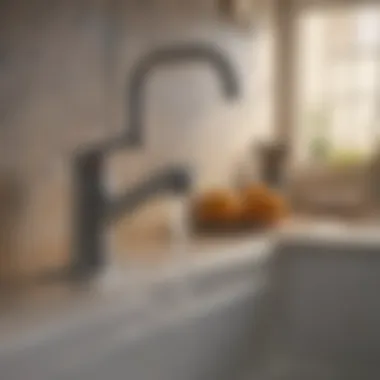
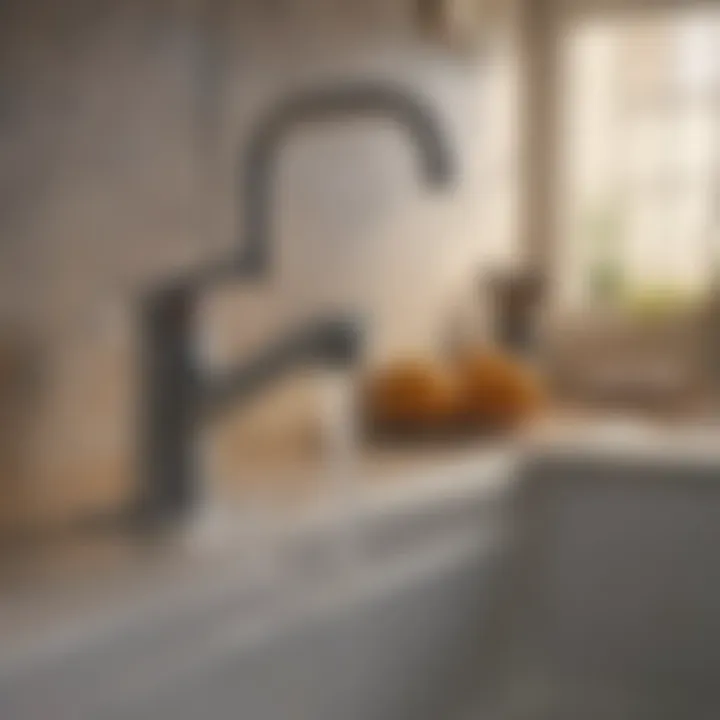
Intro
A leaky kitchen sink faucet is not just an annoyance; it can signify larger issues if left unattended. Understanding how to effectively resolve this common problem is vital for homeowners. Not only can a leak be a source of wasted water, leading to higher utility bills, but it can also potentially cause damage to cabinetry and flooring over time. This guide aims to provide a comprehensive approach to identifying, fixing, and preventing leaks in kitchen sink faucets, equipping you with the necessary knowledge and skills.
Overview of Topic
When discussing the mechanics of home improvement, a leaky faucet can serve as a prime example. It directly relates to the plumbing aspects of home maintenance and underscores the importance of addressing minor issues before they become major headaches. The ability to fix a kitchen sink faucet allows homeowners to take control of their living environment, making it an essential skill.
The importance of addressing leaks cannot be understated. A persistent drip can result in water wastage and escalate repair costs. Moreover, ignoring leaks can lead to mold growth, which poses health risks. Therefore, understanding the common causes and solutions of faucet leaks is crucial for maintaining a healthy household.
Common Challenges and Solutions
Homeowners often encounter a few common challenges when dealing with a leaky kitchen sink faucet:
- Identifying the Source of the Leak: The leak may stem from various components, such as worn-out washers, O-rings, or even the faucet itself.
- Accessing Tight Spaces: Many faucets are located in cramped areas, making it difficult to see and reach components for repair.
- Selecting the Right Replacement Parts: This can be tricky, especially if the homeowner is unfamiliar with plumbing supplies.
Solutions and Tips
To overcome these challenges, consider the following solutions:
- Inspect Carefully: Take time to examine the faucet. Look for any visible signs of wear.
- Utilize the Right Tools: Essential tools may include adjustable wrenches, screwdrivers, and plumbing tape. Invest in a good set to simplify the process.
- Consult Product Manuals: Most faucets come with documentation that details common issues and replacement parts.
- Don’t Hesitate to Seek Help: If the problem seems too complex, enlisting a professional may save time and ensure safety.
Starting a repair without proper knowledge can lead to further damage or additional leaks.
Product Recommendations
Choosing quality parts is essential for successful repairs. When searching for replacement parts or tools for fixing your kitchen sink faucet, consider the following brands known for their reliability:
- Moen: They offer a variety of durable faucets and parts, widely available through most home improvement stores.
- Delta: Known for their innovative designs, Delta provides quality faucets that can withstand regular usage.
- Kohler: A reputable brand, Kohler focuses on combining style with functionality, offering a range of products for repairs.
Let's delve into the benefits of selecting high-quality products:
- Durability: Quality products often last longer, reducing the need for frequent replacements.
- Warranty Options: Many reputable brands offer warranties, providing peace of mind.
- Improved Functionality: Quality replacements can lead to better water flow, enhancing what should be a straightforward task.
Step-by-Step Guides
Fixing a leaky kitchen sink faucet can often be broken down into manageable steps:
- Turn Off the Water Supply: Before starting any work, ensure the water supply to the faucet is turned off.
- Remove the Faucet Handle: Use a screwdriver or wrench to take off the handle carefully, exposing the internal components.
- Inspect for Worn Parts: Identify any damaged washers, seals, or O-rings.
- Replace Damaged Components: Swap out old parts with new ones. Make sure they are compatible with your specific model.
- Reassemble the Faucet: Put the faucet back together, ensuring all screws are tight and parts are fitted securely.
- Turn On the Water Supply: Gradually restore the water supply and check for leaks.
Taking even a few moments to go through the steps carefully can make a significant difference.
Ensuring proper maintenance will enhance the longevity of your faucet, keep your kitchen running smoothly, and help prevent future leaks. Tracking your progress and making adjustments as needed will empower you in handling similar home maintenance issues in the future.
Prelims to Faucet Leaks
Faucet leaks are a common problem in many homes. These leaks not only waste water but also contribute to higher utility bills. Understanding why your kitchen faucet might leak is crucial. It helps homeowners not only to resolve the immediate issue but also to prevent future occurrences.
The significance of learning about faucet leaks goes beyond mere repairs. It provides essential insights into the components of your faucet, the types that are common in kitchens, and how to troubleshoot effectively when problems arise. This knowledge empowers homeowners to take initiative when faced with a leaking faucet, rather than waiting for professionals who might take more time and incur additional costs.
By understanding the underlying causes of faucet leaks, homeowners can make informed decisions on repairs or replacements.
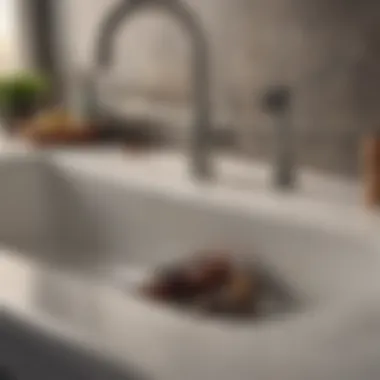

"An ounce of prevention is worth a pound of cure." This adage holds true for faucet maintenance as well, as timely interventions can save significant headaches and expenses later.
Whether you are facing a persistent drip or a more substantial leak, realizing the root of these issues can lead to quicker resolutions. Thus, understanding faucet components and the common types of kitchen sink faucets are foundational knowledge for every homeowner.
Understanding Faucet Components
To tackle a leaky faucet, first, you must familiarize yourself with its components. A faucet generally consists of several key parts: the handle, spout, cartridge (or valve), O-rings, and washers.
- Handle: This part controls the flow of water. When turned, it operates the cartridge inside the faucet.
- Spout: The visible portion from which water flows. It directs the water at a suitable angle to the sink.
- Cartridge or Valve: The mechanism that regulates water flow and temperature. It can wear out over time, leading to leaks.
- O-rings: Small rubber rings that help create seals between various parts. If they become worn, they can lead to leaks.
- Washers: These are flat rubber components that also help create seals, particularly in compression faucets.
Understanding these components can greatly aid in identifying where the leak might originate.
Common Types of Kitchen Sink Faucets
Not all kitchen faucet assortments are identical; knowing the different types can help in the repair process. Here are the most common types of kitchen sink faucets:
- Compression Faucets: These consist of two handles—one for hot and another for cold water. They use washers to seal the water flow. When these washers wear out, leaks commonly occur.
- Ball Faucets: These are single-handle faucets. The mechanism contains a ball bearing that controls the flow and temperature. Wear and tear on the internal parts can lead to leaks around the spout.
- Cartridge Faucets: These have a single or double handle. The cartridge controls water flow and temperature. When the cartridge is faulty, you'll often notice leaks.
- Ceramic Disc Faucets: These use a pair of ceramic discs to regulate water flow. They are durable and typically less prone to leaks compared to other types.
- Pull-Down and Pull-Out Faucets: These models are popular for their flexibility. They have a convenient spray head that can be pulled down or out of the main faucet. Leaks can arise from the hose or connections between the head and faucet.
By recognizing your faucet type, you can better approach repairs and replacements when necessary.
Identifying a Leak in Your Faucet
Recognizing a leak in your faucet is crucial for timely repairs and prevents further water damage. A small drip can lead to larger problems if left unaddressed. Early detection can save both money and time. It ensures that repairs are less complicated and minimizes the stress associated with plumbing issues.
Signs of a Leaky Faucet
There are several indicators that your faucet may be leaking.
- Water pools: A puddle around the base of the faucet can be a clear sign.
- Dripping sound: The constant sound of water dripping is not only annoying but also a potential indicator.
- Moisture stains: Check for damp spots on cabinets or surfaces beneath the sink.
- Increased water bill: If you notice a sudden rise in your water usage, a leaky faucet could be to blame.
- Rust or corrosion: Inspect the faucet for rust; it can suggest prolonged leak exposure.
It is essential to monitor these signs regularly. Addressing them doesn't just solve the immediate issue; it also maintains the overall health of your plumbing.
Where to Look for Leaks
When checking for leaks, focus on specific areas of the faucet and surrounding components.
- Faucet handle: Sometimes, the handle fitting may not be secure, allowing water to escape.
- Base of the faucet: Inspect where the faucet meets the sink for any visible leaks or corrosion.
- Sprayer connection: If your setup includes a sprayer, make sure to check that connection as well.
- Water supply lines: Look at the lines connecting the faucet to the water source. These lines can wear out and cause leaks.
- Sink bowl: It is wise to inspect under the sink for signs of leaks, especially if you cannot find the source above.
A thorough inspection can help pinpoint the issue accurately. Addressing leaks quickly is vital in preventing larger plumbing problems.
Tools Required for Repairs
Addressing a leaky kitchen sink faucet entails more than simple knowledge of the components involved in the plumbing process. It requires the right tools. Without them, the repairs may become cumbersome or even impossible. Therefore, understanding the tools required for effective repairs is a vital aspect of this entire process.
The primary benefit of having the appropriate tools is efficiency. With the right equipment, you can complete the repairs quicker. No one wants to spend their day fixing leaks when a well-equipped toolkit can facilitate the process. Moreover, having the right tools minimizes the chance of causing further damage to the faucet, which could result in increased costs down the line.
When planning repairs, it is essential to consider what each tool does. Each tool serves a specific purpose, contributing to the overall success of the repair project. Thus, familiarity with the tools and their uses can save time and frustration. Proper preparation ensures that you can dive into the repairs without unnecessary interruptions.
Essential Hand Tools
To fix a leaky kitchen sink faucet effectively, there are some tools that stand out as essential. First, you typically need a wrench. This tool is required for loosening and tightening nuts and fittings. A pair of plumbers pliers can also be helpful. They offer a strong grip, which is particularly useful when dealing with stubborn components.
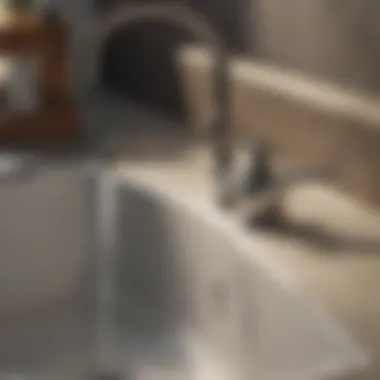
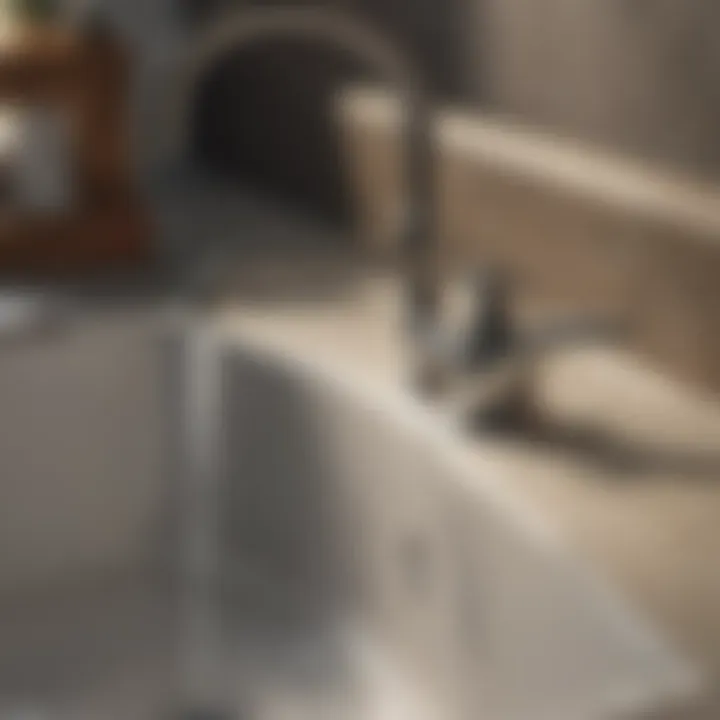
Another handy tool is a screwdriver, preferably a set that includes both flat-head and Phillips types. This will allow you to remove screws holding various parts of the faucet together. In many cases, an adjustable wrench is good for tightening or loosening faucet components as well. It offers versatility and works well around minimal spaces.
Among these tools, a bowl or container for collecting excess water is often overlooked. When disassembling the faucet, water may still linger in the pipes, and having a place to catch that water prevents a mess. Finally, rags or towels are useful for cleaning up any spills and ensuring your workspace remains tidy.
Replacement Parts Considerations
When repairing a faucet, it is crucial to think about replacement parts. Having the right replacement components on hand can avoid repeated trips to the store and unnecessary delays. Individual parts like washers and O-rings are commonly the culprits in leaks. Identifying the sizes and types required for your faucet model can make a significant difference in the repair process.
Before starting any repair, it is wise to check the condition of other components like seals, springs, or cartridge parts. Often, multiple components may be worn down in conjunction with the original leak. Therefore, preparing for potential additional replacements could save time.
It is also important to consider the quality of the replacement parts. Although it may seem tempting to buy the cheapest options, saving a few dollars can lead to further issues in the long run. Always aims to choose durable parts that fit your faucet's specifications. This ensures a longer-lasting solution for your leaky faucet.
In summary, being well prepared with the right tools and understanding the necessary replacement parts is critical in resolving faucet leaks efficiently. The right approach not only speeds up the process but also guarantees a higher likelihood of success in making your kitchen sink faucet functional and leak-free.
Steps to Fix a Leaky Kitchen Faucet
Fixing a leaky kitchen faucet can seem daunting, but it is a necessary task for any homeowner. This process not only helps save water but also prevents potential damage to your kitchen from leaks. By following the steps outlined below, you can ensure that the repair is done correctly, prolonging the lifespan of your faucet and contributing to a smoother plumbing system.
Shutting Off the Water Supply
Before starting any repair work on your faucet, the first critical step is to shut off the water supply. This action prevents any flooding or water damage while you're working. Typically, the water supply can be turned off at the shut-off valves located below the sink. If these valves are not functioning properly, turning off the main water supply to your home may be necessary. It is always best to test the faucet after turning the supply off, ensuring there are no leaks and that you are ready to proceed with the repair.
Disassembling the Faucet
Once the water supply is turned off, you can begin disassembling the faucet. Use a screwdriver to take off the handle. Depending on the faucet design, you might need to remove a decorative cap to access the screw. Pay attention to how the faucet is assembled, as returning it to its original state will be important later. It can be helpful to keep track of the pieces, possibly by laying them out in the order you removed them. Consider taking a picture of the faucet before disassembly to serve as a reference.
Inspecting Washers and O-Rings
The next step involves inspecting the washers and O-rings that are integral to the proper functioning of your faucet. These components are often the source of leaks. Check for signs of wear, such as cracks, fraying, or brittleness. If you notice any damage, it is highly likely that replacing them will resolve your leak. Measure the existing parts to ensure a proper fit for replacements. Keeping a small container nearby can help you organize any small parts and avoid losing them.
Replacing Damaged Components
When you have identified damaged components, it is time to proceed with replacing them. Purchase quality parts that match your specific faucet type. Sometimes, the best practice is to bring the old components to the hardware store to ensure that you are getting the correct size and type. Installing the new washers or O-rings should be done carefully; ensure they sit flat and snug in their respective locations to guarantee a tight seal.
Reassembling the Faucet
After replacing the damaged parts, you must reassemble the faucet. Follow the order of disassembly to ensure every component goes back in the correct position. Screw the handle back into place, and remember to reattach any decorative covers. Taking care during reassembly is important, as improper placement might lead to future leaks. As each part is installed, verify that it is secure without over-tightening, which could cause damage.
Testing for Leaks
Once the faucet has been reassembled, it is time to test for leaks. Turn on the water supply gradually and check all joints and connections closely. It is wise to let the water run for a few minutes and observe for any dripping or signs of leakage. If the faucet operates correctly without leakage, then you have successfully repaired your kitchen sink faucet. If leaks persist, you might need to reassess your work to ensure that all parts were replaced correctly and tightly.
Properly fixing a leaky faucet can save significant amounts of water and prevent further plumbing issues down the line.
Preventative Measures
Preventative measures are essential in maintaining the integrity of your kitchen sink faucet. Ensuring your faucet operates smoothly can save both time and money. A proactive approach minimizes the likelihood of leaks, prolongs the lifespan of your fixtures, and enhances the overall efficiency of your plumbing system. This section explores specific strategies to achieve these benefits.
Regular Maintenance Practices
Routine maintenance is vital in preventing leaks and other issues. Here are practical practices:
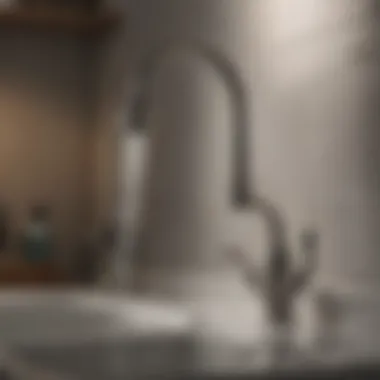

- Inspect Regularly: Check for any signs of wear and tear on the faucet. Look for corrosion, loose handles, or discolored parts.
- Clean Faucet Aerators: Mineral build-up can affect water flow and increase pressure on interior components. Remove and clean aerators every few months.
- Check Water Pressure: High water pressure can cause leaks in faucets. If the pressure is excessive, consider using a pressure regulator.
- Lubricate Moving Parts: Periodically apply plumber’s grease to moving components such as handles and valve stems. This can help prevent friction and damage.
- Address Minor Issues Promptly: If you notice any slight drips or leaks, address them immediately. Ignoring small problems can lead to larger, more expensive repairs down the line.
Choosing Quality Fixtures
Selecting quality fixtures can significantly reduce the risk of leaks in your kitchen sink faucet. Here are some critical points to consider:
- Research Brand Reputation: Choose reputable brands known for their durability and reliability. Brands like Moen, Delta, and Kohler are often recognized for their quality.
- Opt for Trusted Materials: Look for faucets made from sturdy materials such as stainless steel or solid brass. These materials are less likely to corrode or fail.
- Consider Warranty Offers: Many manufacturers provide warranties on their products. A good warranty indicates the manufacturer’s confidence in their product.
- Evaluate Installation Ease: Fixtures that are easier to install often come with clear guidelines. This can prevent future issues stemming from poor installation.
- Read Reviews: Look for reviews and ratings from other users. Feedback can provide insight into performance, usability, and longevity.
By implementing these preventative measures, homeowners can significantly extend the life of their kitchen faucets and reduce the risk of future repairs.
When to Call a Professional
Recognizing when to consult a professional for a leaky kitchen sink faucet is crucial for ensuring that the problem is addressed correctly and efficiently. While many DIY repairs can be performed with basic tools and knowledge, some situations warrant the expertise of a trained plumber. Engaging a professional not only brings technical skill but also peace of mind. Here are some important factors to consider when deciding whether to tackle repairs on your own or seek professional assistance.
Assessing Repair Complexity
The complexity of a repair can vary significantly based on the type of faucet and the nature of the leak. Simple leaks, caused by worn-out washers or O-rings, often can be fixed with a few tools and some guidance. However, if the issue involves intricate components or multiple leaks originating from various areas, it might be time to evaluate the need for a professional.
Indicators of complexity include:
- The faucet type: Cartridge, compression, ball, or disc.
- The presence of rust or corrosion, which can complicate the repair process.
- Difficulty in accessing plumbing connections due to limited space or positioning.
If you feel overwhelmed or unsure about the repair steps, a professional can ensure that the job is done right.
Identifying Significant Damage
Assessment of damage severity is critical in deciding whether a repair is within reach or requires a professional's touch. Signs of significant damage may include:
- Leaking water under the sink or cabinet: This can indicate a more serious issue such as pipe damage or a failing water supply line.
- Consistent dripping when faucet is turned off: This may suggest a deeper problem, such as a damaged valve seat or structural issues within the faucet.
- Unusual noise or vibrations: Sounds that do not commonly occur during normal operation may signal internal malfunction.
If you observe any of these signs, it’s prudent to call a plumber. Not only can they provide the necessary expertise, but they can also identify underlying issues that might be difficult for a homeowner to detect.
Remember: Handling complex repairs without proper knowledge may lead to greater expenses down the line. Prioritize safety and efficiency by considering professional help when necessary.
Epilogue
Addressing a leaky kitchen sink faucet is crucial for both efficiency and maintenance. Understanding the steps necessary to resolve such issues can empower homeowners, ensuring they save money on water bills and prevent further damage to their plumbing.
In this article, we have explored essential points such as identifying the leak, disassembling the faucet, and replacing damaged components. This knowledge equips individuals to take proactive measures that can reduce the likelihood of future leaks. Moreover, grasping when to rely on a professional can minimize stress and ensure the plumbing system remains functional.
Integration of regular maintenance practices plays a pivotal role in extending the lifespan of faucets and fixtures. Fully appreciating the simple actions one can take to maintain their plumbing is just as significant as performing repairs when leaks occur. This guide serves as a valuable resource, consolidating both preventative and remedial measures.
"Effective plumbing maintenance is a commitment that pays off considerably in the long run."
Understanding the nuances of each aspect mentioned, from identifying leaks to understanding when to consult a professional, is not only beneficial for homeowners but essential for maintaining a well-functioning home environment.
Summary of Key Points
- Identifying a Leak: Properly recognizing the signs of a leaky faucet is the first step. Common indicators include water dripping or pooling under the sink.
- Tools and Parts: Having the right tools like wrenches and screwdrivers, as well as understanding necessary replacement parts such as washers and O-rings, is vital.
- Repair Steps: Following a systematic approach—from shutting off the water supply to testing for leaks—is crucial in effective repairs.
- Preventative Measures: Regular maintenance and choosing quality fixtures can prevent future occurrences of leaks, saving time and money.
- Professional Help: Knowing when to hire a professional avoids complications and ensures that significant damages are addressed appropriately.
Final Recommendations
To maintain fluidity in household plumbing systems, the following recommendations are useful:
- Perform routine checks on your faucet and plumbing systems to catch early signs of wear.
- When replacing components, opt for quality materials that can withstand wear over time.
- Keep a toolkit handy with essential repair tools and some common replacement parts. This preparedness can make a big difference in timely repairs.
- Consult available resources for guidance on larger repairs or situations that exceed typical household skills.
- If repairs seem overwhelming or involve unfamiliar plumbing systems, consider seeking professional assistance to ensure a job well done.
By adhering to these recommendations, homeowners can significantly extend the longevity of their kitchen fixtures, maintain their home’s functionality, and enjoy peace of mind regarding their plumbing.







